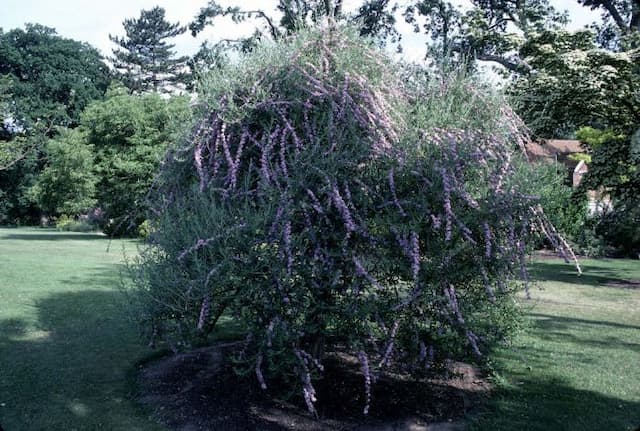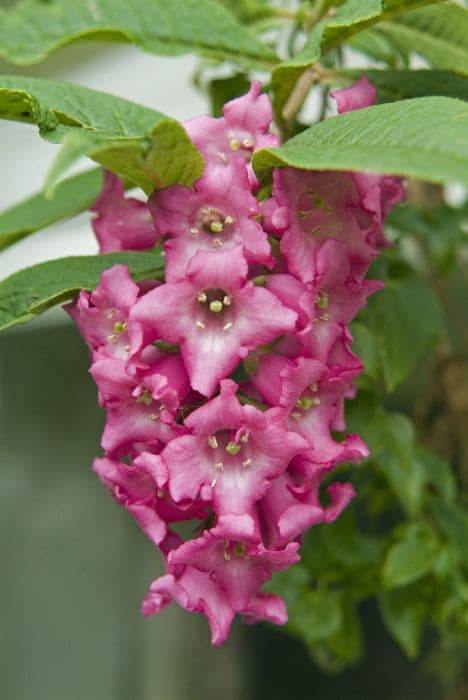Butterfly Bush Buddleja davidii 'Pink Pearl'

ABOUT
The plant known as Pink Pearl is a flowering perennial renowned for its attractive blooms and ability to attract butterflies. The plant is characterized by its arching branches laden with dense clusters of tiny, tubular flowers that come in a delightful shade of soft pink. The flower clusters are elongated and conical, resembling plumes that elegantly sway with the breeze. The foliage of Pink Pearl is equally appealing, featuring spear-shaped leaves that are a deep green hue, offering a lush backdrop to the pastel flowers. The leaves have a slightly serrated edge and are arranged in an opposing pattern along the stems, which can sometimes take on a squared appearance. As the seasons change, Pink Pearl blooms profusely, especially in the sunnier months, and the flowers persist for a long period, providing a long-lasting display of color in the garden. The plant's overall structure forms a pleasing shape that adds ornamental value to any planting arrangement without overwhelming nearby plants. Its distinctive flower form and color give Pink Pearl a subtle yet undeniable charm that can enhance a variety of garden styles.
About this plant
 Names
NamesFamily
Scrophulariaceae
Synonyms
Butterfly Bush, Summer Lilac, Orange Eye
Common names
Buddleja davidii var. superba, Buddleia variabilis, Buddleia davidii, Buddleja variabilis
 Toxicity
ToxicityTo humans
The plant commonly known as Butterfly Bush is not considered highly toxic to humans. However, it can potentially cause mild irritation to the skin or stomach if ingested or handled. There is not a wealth of information on severe poisoning in humans due to the butterfly bush, and it is generally not regarded as a plant that causes significant toxic effects upon ingestion. As with any plant, individuals may have specific allergies or sensitivities that could result in reactions, so it is advisable to exercise caution and keep the plant out of reach of small children who may be tempted to eat it.
To pets
Butterfly Bush is not known to be highly toxic to pets, including cats and dogs. Although it is not considered a major risk, it is still advisable to prevent pets from ingesting the plant. Eating significant amounts might cause mild gastrointestinal upset, such as vomiting or diarrhea, due to the plant's non-digestible parts or possible chemical irritants. As with any non-food plant, it's generally a good practice to monitor pets and discourage them from chewing on plants that are not meant for consumption, to avoid any potential issues. However, the Butterfly Bush is not commonly listed as a plant that is known to cause serious or life-threatening symptoms in pets.
 Characteristics
CharacteristicsLife cycle
Perennials
Foliage type
Deciduous
Color of leaves
Green
Flower color
Pink
Height
6-8 feet (1.8-2.4 meters)
Spread
4-5 feet (1.2-1.5 meters)
Plant type
Shrub
Hardiness zones
5-9
Native area
China
Benefits
 General Benefits
General Benefits- Attracts pollinators: The Buddleja davidii 'Pink Pearl', commonly known as Butterfly Bush, features blooms that attract butterflies, bees, and other beneficial insects to the garden.
- Drought-tolerant: Once established, this plant can tolerate periods of low water, reducing the need for frequent watering.
- Fast growth: The Butterfly Bush is known for its rapid growth, allowing gardeners to quickly enjoy its flowers and fullness.
- Easy to care for: It is relatively low-maintenance, requiring minimal upkeep beyond occasional pruning and deadheading to promote continued blooming.
- Long blooming period: The plant produces flowers from early summer to autumn, providing a long season of visual interest.
- Aesthetic appeal: 'Pink Pearl' offers showy pink flower spikes that can enhance the beauty of garden landscapes and outdoor spaces.
- Wildlife habitat: The flowers provide nectar for butterflies and other insects, making it an excellent choice for wildlife gardens.
- Privacy screening: With its tall and dense growth habit, the Butterfly Bush can be used to create a natural screen or hedge for privacy.
 Medical Properties
Medical Properties- This plant is not used for medical purposes.
 Air-purifying Qualities
Air-purifying QualitiesThis plant is not specifically known for air purifying qualities.
 Other Uses
Other Uses- Butterfly Garden Attraction: Buddleia is commonly planted to attract butterflies to gardens, creating a diverse and dynamic ecosystem.
- Photography Backdrop: The vibrant pink blooms of 'Pink Pearl' make a beautiful background for outdoor photography.
- Horticultural Education: This plant can be used as a teaching tool in horticulture classes to demonstrate pruning techniques and care of flowering shrubs.
- Landscape Design: 'Pink Pearl' can be used as a focal point in garden design, particularly in cottage and informal gardens.
- Dye Production: The flowers can potentially be used to make a natural dye for coloring fabrics, though this is not a common practice.
- Nectar Source for Homemade Syrups: The nectar from the blooms can be used to create sweet syrups for culinary purposes.
- Artistic Inspiration: Artists can use the intricate structure of the flowers and leaves as inspiration for paintings, drawings, or textiles.
- Plant Propagation Practice: The easy propagation of Buddleia makes it a suitable plant for gardening enthusiasts to practice their propagation skills.
- Erosion Control: When planted in groups, Buddleia can help stabilize soil and prevent erosion in sloped areas of the garden.
- Privacy Screening: With its dense growth habit, 'Pink Pearl' can be used as a natural screen to create privacy in a garden setting.
Interesting Facts
 Feng Shui
Feng ShuiThe Butterfly Bush is not used in Feng Shui practice.
 Zodiac Sign Compitability
Zodiac Sign CompitabilityThe Butterfly Bush is not used in astrology practice.
 Plant Symbolism
Plant Symbolism- Transformation: The Buddleja davidii 'Pink Pearl', commonly known as Butterfly Bush, is often associated with change and transformation due to its ability to attract butterflies, which are symbols of metamorphosis.
- New Beginnings: With its rapid growth and ability to rejuvenate after pruning, the Butterfly Bush symbolizes fresh starts and the beginning of new ventures or phases in life.
- Attraction: The sweet scent and vibrant colors of the Butterfly Bush are known to draw in various pollinators, illustrating the plant's symbolism of allure and magnetism.
- Survival: Due to its hardy and resilient nature, the Butterfly Bush can often thrive in challenging conditions, representing perseverance and the ability to overcome adversity.
- Inspiration: The presence of butterflies around the plant, coupled with its lush blooms, makes the Butterfly Bush a symbol of creativity, inspiring joy and a sense of wonder.
- Peace: The serene beauty of the Butterfly Bush's flowers is said to bring peace and tranquility to any garden or space, symbolizing calmness and restfulness.
 Water
WaterThe Butterfly Bush should be watered deeply once a week, providing about 1 inch of water which equates to approximately 0.6 gallons per square yard. During hot, dry periods, the frequency may increase to twice a week. It’s important to water the plant at its base, avoiding overhead watering to prevent leaf diseases. Allow the soil to dry out slightly between waterings to encourage deep root growth and avoid waterlogging. Over the winter months, reduce watering significantly, but do not allow the soil to become completely dry.
 Light
LightThe Butterfly Bush thrives in full sunlight, requiring a minimum of 6 hours of direct sunlight per day to perform well. Place the plant in a spot where it is exposed to uninterrupted sun for most of the day. Partial shade is tolerated, but too much shade can result in fewer flowers and a leggy growth habit.
 Temperature
TemperatureThe Butterfly Bush is resilient in a wide range of temperatures and can survive winters where the temperature drops as low as -20°F. During the growing season, it prefers temperatures between 60°F and 90°F. The ideal conditions for flowering are warm, sunny days. Extended periods of extreme cold might damage the plant and require some protection.
 Pruning
PruningPruning is essential for the Butterfly Bush to maintain its shape and promote vigorous growth. Prune in late winter or early spring before new growth starts, by cutting back the previous year's growth to about a foot from the ground. This will stimulate the emergence of new shoots and an abundance of flowers. Deadheading spent flowers during the growing season can also encourage more blooms.
 Cleaning
CleaningAs needed
 Soil
SoilButterfly Bush prefers well-draining soil with high fertility and a pH between 6 and 7. A mixture of loam, compost, and coarse sand is ideal to ensure proper drainage and nutrition.
 Repotting
RepottingThe Butterfly Bush should be repotted every 2-3 years to refresh the soil and accommodate root growth, being careful not to damage the root system during the process.
 Humidity & Misting
Humidity & MistingButterfly Bush thrives in average outdoor humidity levels and does not require special humidity adjustments when grown in its natural outdoor environment.
 Suitable locations
Suitable locationsIndoor
Ensure full sun, well-draining soil, and regular pruning.
Outdoor
Plant in full sun, well-drained soil, water deeply but infrequently.
Hardiness zone
5-9 USDA
 Life cycle
Life cycleBuddleja davidii 'Pink Pearl', commonly known as the Pink Butterfly Bush, starts its lifecycle with seed germination in warmer temperatures, usually in spring. Once germinated, seedlings establish roots and produce their first sets of true leaves. As the plant enters the vegetative stage, it develops a woody stem and branches, with foliage growth intensifying during the growing season. The Pink Butterfly Bush enters the flowering stage in early to mid-summer, producing cone-shaped clusters of pink flowers that attract pollinators such as butterflies. After pollination, it sets seed which can be dispersed by wind or animals. In late fall or winter, the plant may enter dormancy, losing leaves in colder climates, to conserve energy for the next growing season.
 Propogation
PropogationPropogation time
Spring to early summer
The Buddleja davidii 'Pink Pearl', also known as the Butterfly Bush, is commonly propagated through semi-hardwood cuttings during the summer months. To propagate by cuttings, a gardener should select a healthy, non-flowering shoot and cut a 4 to 6-inch (about 10 to 15 cm) long section. The lower leaves are then removed, and the cut end is dipped into a rooting hormone to encourage root development. The cutting should be placed in a well-draining potting mix, ensuring that a few nodes where the leaves were removed are buried as these areas are where roots are most likely to develop. The environment should be kept humid by covering the pot with a plastic bag or placing it in a propagator, and the cutting should be kept in indirect sunlight until roots have formed, which typically takes a few weeks.

![Butterfly bush [Berries and Cream]](/_next/image?url=https%3A%2F%2Fplants-admin.emdemapps.com%2Fimages%2Fplants%2F%2Fimages%2F604b650f667be.png&w=640&q=75)






![Butterfly bush [Nanho Blue]](/_next/image?url=https%3A%2F%2Fplants-admin.emdemapps.com%2Fimages%2Fplants%2F%2Fimages%2F604b55d0a6d2d.png&w=640&q=75)